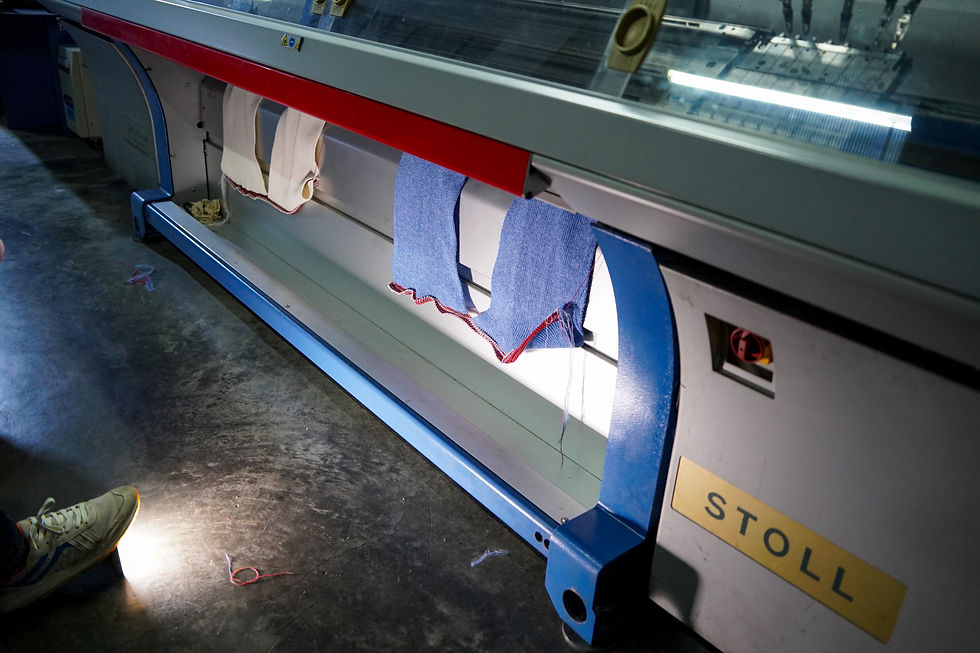What can you make with a knitting machine?
- Knit-Lab Peru

- hace 2 días
- 4 Min. de lectura
Knitting machines have many settings that need to be changed and checked all through the knitting process. For knitwear manufacturers, properly managing these settings is essential to ensuring consistent quality and efficiency. It’s important to keep close to the operating manual so you can follow the instructions for every technique.
As you learn to knit you should practice the basic techniques like cast on, knit, cast off, increase, decrease, transfer stitches. Try creating lots of samples that will help you learn about different techniques, tensions and patterns. The smaller garments will show up where you need to improve.

So what can knitting machines do?
Automatic Stitch Techniques
Modern knitting machines can perform a variety of interesting stitch techniques without a rubber or garter carriage. These include fair isle, tuck, skip, normal lace, fine lace, thread lace, weaving, plating, and intarsia.
Fair Isle
Fair isle refers to stranded knitting using two colors, just like in hand knitting. The main color knits on needles in working position, and the alternate color knits on needles in upper working position. Although only two colors can be used in any given row, these can be changed from row to row, giving you more options.

You might also: Different types of knit fabrics
Tuck Stitch
In tuck stitch, the needles in the working position knit normally. The needles in the upper working position don’t knit, but an extra loop of yarn is laid over them with each pass of the carriage. When these needles are returned to working position, all the loops on the needle knit in a single stitch, resulting in a textured fabric.
Skip Stitch
Skip stitch is the machine knitting equivalent of slipping instead of knitting a stitch. As in tuck stitch, the needles in the working position knit and the needles in the upper working position don’t. However, no extra loops of yarn are laid over the needles in the upper working position, so when the needle finally knits, it’s a single, longer stitch. As with tuck stitch, the yarn can be changed on any row to produce mosaic effects.
Normal Lace
Normal lace is the machine equivalent of traditional hand knitted lace. It requires the use of a special lace carriage in addition to the knitting carriage. When the lace carriage is passed over the needles, stitches in the upper working position are transferred or moved to adjacent needles. Then, when the knit carriage is passed over the bed, needles with multiple stitches knit normally (the equivalent of “knit 2 together”), and needles with no stitch are cast on (the equivalent of a “yarn over”), creating the characteristic holes.
Fine Lace
Fine lace is a textured fabric that is probably most similar to the effect you get when you twist stitches in hand knitting. It’s worked in exactly the same way as normal lace. However, when a transfer is made, the stitch remains on the original needle while also being stretched onto an adjacent needle.
Thread Lace
Also called “punch lace”, thread lace is essentially a fair isle done with a regular yarn and a matching thread. Because the thread is so much thinner, it barely shows, making it appear that the fabric has lace holes in it.
Weaving
Weaving is actually a knitted technique using a backing yarn and a weaving yarn. The machine automatically places needles in either the working or upper working position according to the design pattern. The knitter manually places the weaving yarn along the needles in the upper working position, and then passes the knit carriage over them. The backing yarn knits normally, but catches in the weaving thread on those needles, forming floats of different lengths on the surface of the fabric. The floats appear as a woven pattern on the wrong side of the fabric.
Plating
Plating is normal stockinette stitch done with two separate yarns. The main yarn knits normally, and the alternate yarn knits behind it simultaneously. This produces a “lined” knit fabric, which is useful if your main yarn is scratchy. The alternate yarn shows through a little bit, giving subtle color variations.
Intarsia
Intarsia is the most labor-intensive of the manual techniques. The knitter places each color yarn on the appropriate needles before passing a special intarsia carriage over them. The yarns are threaded through special weights that hang down from the needle bed to help maintain good tension. On some machines, the knit carriage has a special setting so a separate intarsia carriage is not needed.

Cables
Cables can be formed by manually transferring stitches to other needles on the appropriate row. Although a complicated cable pattern can be labor intensive, cables usually work up quickly since the transfer is made on a small percentage of the rows.
Hand Manipulated Stitches
Hand manipulated stitches include twisting, wrapping, weaving, lifting, rehanging and transferring stitches to create textured fabrics. These techniques result in surface embellishments, puckers, relief patterns, gathers, ruching, bobbles, popcorn, pintucks, fringes, and trims, even beading. There is almost no limit to the variety a knitter can achieve.
Pattern Variations
Electronic knitting machines may also include pattern variation buttons that allow the knitter to change a design that’s already been input, either by the knitter or pre-programmed. These include reverse, mirror image, upside down, reflection (vertical mirror image), double width, double length, rotation, negative, multi-color rib (jacquard), and single motif. Using double width and double length together will automatically make your design four times larger without having to re-enter it.
Hope you enjoyed this article! Here at Knit-Lab Peru we are committed to offer premium quality products that combine modern technology with ancestral tradition. Contact us if you want to learn more or work with us.















Comentarios